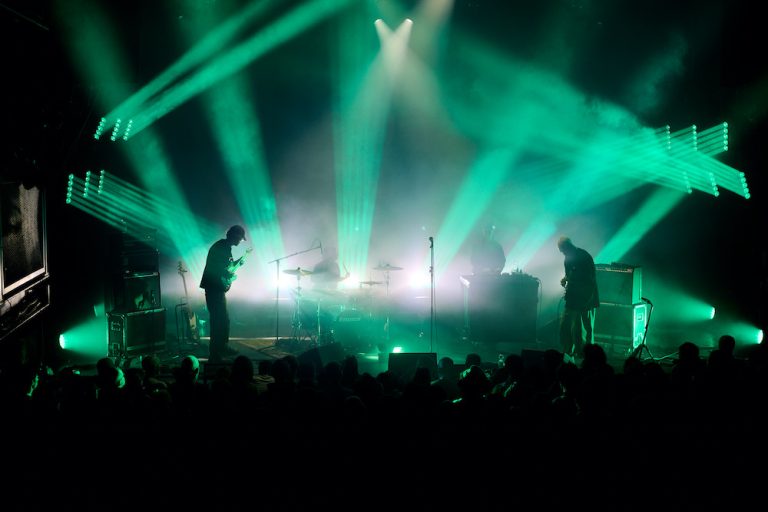Beats Per Minute’s Jasper Willems once again descended down on The Hague’s always adventurous Rewire festival, and noticed a stronger onus towards the physical than in year’s past.
The noise of the world can be unbearable. Peering into our little devices, we’ve been bombarded by similes of children murdered in Gaza by Israeli forces, alternated by AI-generated facsimiles of Studio Ghibli works. The very devices we compulsively cling to are in fact the product of exploited manual labor halfway across the world. Becoming cynical or angry is the most logical response to all this strife. To shift our attention on things we find beautiful, inspiring or intellectually stimulating strikes as a misplaced sort of naïveté.
Luckily, Rewire is the kind of festival where the dynamic between music and audience is hardly ever a one-way street – a phenomenon constantly interrogated, assimilated and in metamorphosis. One performance might leave us exulting into the marvellous or grandiose, while the next will ground us back into the glowing present. Furthermore, Rewire does a much better job investigating our relationship with technology than a corporate showcase festival like SXSW, where the tech bros peddle abound. But with technology being deployed to replace art instead of curing breast cancer or doing menial chores – the 64 million dollar question remains where it leaves a forward-thinking event like Rewire: how, where and when can the human-made be absolved again?
Big questions like this always tend to surface when Rewire wraps its tendrils around The Hague’s inner city. Good Sad Happy Bad – kicking things off at PAARD’s main hall – are the perfect act to ease into things. Peculiarly enough, we encounter a who’s who of Dutch indie rock – familiar faces from The Klittens, Pip Blom, Neighbours Burning Neighbours, and Personal Trainer all scurrying together. So wait, Good Sad Happy Bad might be the common denominator of these bands? Interesting indeed!
One thing is abundantly clear when the first notes are played: perfectionism isn’t in the playbook of CJ Calderwood, Raisa Khan, Marc Pel and finally, composer Mica Levi. Their artsy psych pop is chromatic and glossy, but also dithers and jitters like a malfunctioning toy. Though not as sonically thrilling and volatile as Micachu & The Shapes – the group’s infant previous incarnation – Good Sad Happy Bad take a more loose-limbed approach, slow-burning through their offbeat songs with the disposition of the adults in room – albeit the adults who secretly clutch onto their favorite stuffed animal they held as kids, precariously stitched together and never washed.
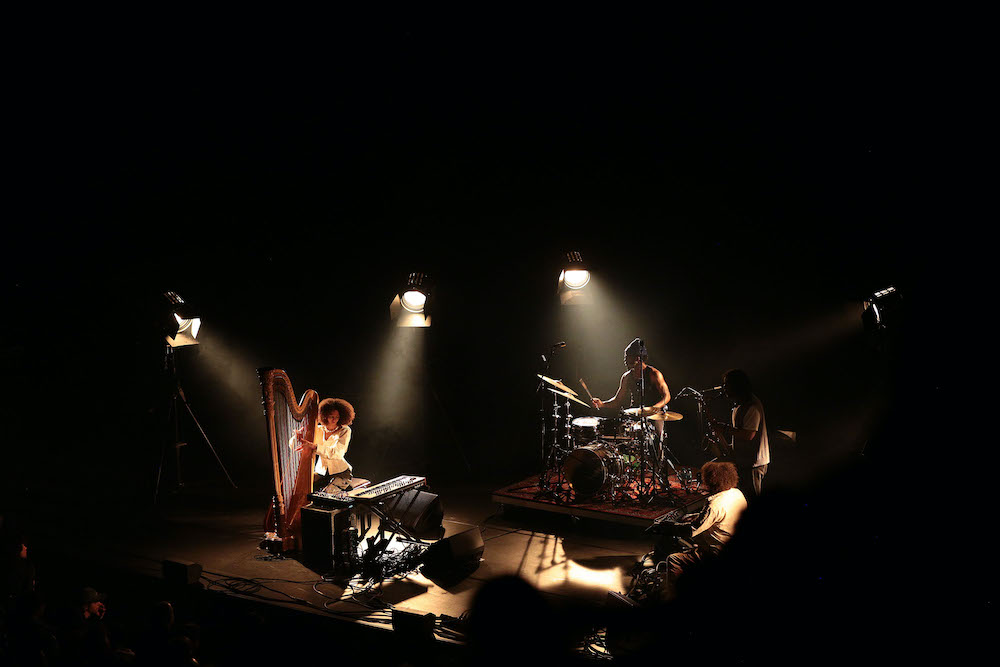
By all means an effective runway towards what was an otherworldly performance at Amare by Nala Sinephro and her band, which also includes Lyle Barton, sax player James Mollison of Ezra Collective and black midi-drummer Morgan Simpson. Sinephro begins the set solo on her pedal harp, unbridling in tonal ripples that both sooth and sparkle – a mere glance at her bandmates is enough of a cue for them to start celestial yarn-spinning with her. What transpires feels less than a concert, and more like a musical broadcast to the very cosmos itself.
When Sinephro switches to her synth station, she activates the rest of her band, creating an almost psionic chemistry that burrows much deeper than just cerebral composing or improvising. I read somewhere she tunes her synths to 432 hertz, the frequency that resonates the most with our internal biology in a healing way. Skeptics dismissing stuff like this as new age pseudo-science might become real believers witnessing this incredible performance – Simpson’s drums cradle and undercut the soothing synth-arpeggio’s like space debris, Barton handling lush melodic swells and boggy textures, and Mollison’s sax soars sky-high like a northern star, often making it quite difficult to hold back tears.
The acoustics are super crisp, and those witnessing have baffled smiles plastered on their faces, heads shaking in sheer disbelief of how this type of music can pour out of these mortal souls. Sporadically, the duo will veer into an impromptu jam as if calling out spirits of jazz music’s past briefly inhabiting them – it sounds like you’re tuning between different radio stations, feint remnants of music fighting within the static noise. Except this is four people creating this effect right before our very eyes. It doesn’t seem possible from a purely sensory perspective.
Though people associate Sinephro’s music with signifiers like ‘meditative’ and ‘soothing’, I was most taken aback by how menacing this set was at times, usually in moments where Simpson takes point: briefly all the melodic textures seemed to putrefy in favour of pure telluric noise. In these moments, you can literally feel your insides run cold, and I caught myself thinking: ‘This must be what it feels like to die’.
But then gradually, Sinephro signals another journey that’ll lift this entire room back into anti-gravity bliss. And the thing is, the visuals were super modest and functional, just a couple of warmly-lit square lamps stationed in a curve, allowing the players to read each other needed. Yet Sinephro and her band made us feel like we’re in that final scene of Close Encounters of the Third Kind when that humongous mothership arrives. If that ever happens for real, they better have them on speed dial. Gosh.
After that scarcely plausible musical display, the subsequent performances I witnessed felt a bit trivial, honestly. YHWH Nailgun‘s clattering noise pop at Concordia and aya‘s sub-bass driven poetry slams at PAARD seemed quaint and insignificant in the wake of that Nala Sinephro performance. Like specks of dust in the wind. That’s hardly on them, mind you. It just boils down to circumstance: I’m pretty sure my mind would be more blown if I had started the evening with those acts. But yeah, it’s indeed a funny realisation, that Nala Sinephro at her most intense was actually heavier than anything YHWH Nailgun tossed at me. How about that?
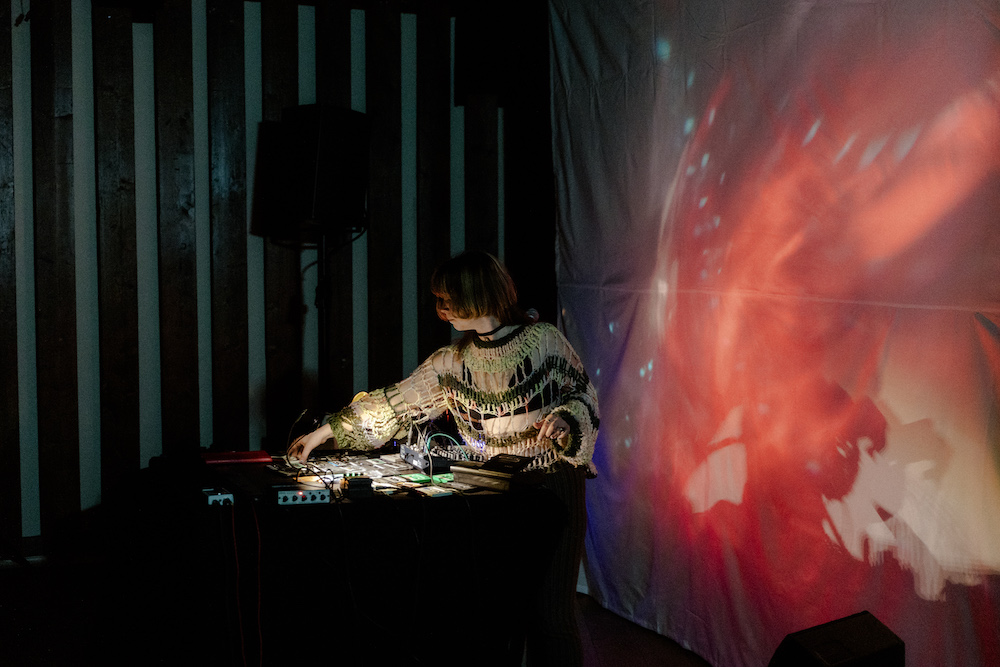
The first act that dented my reverie was Brooklyn’s Kassie Krut, who – upon seeing their incursion on PAARD – have been horribly miskast by yours truly. Apologies to Kassie Krut: you sound nothing like Deerhoof or Battles – and this terrible comparison will be a stain on my permanent record. The lashing received is anything but unpleasant, however: in yeoman’s terms, Kassie Krut sound like a hyperpop act employing the physicality of a rock band, using the tools of an electronic act. Definitely closer in relationship to Fuck Buttons or Black Dice than the bands I mentioned, cherry-topped with their own manic, bloodhound sensibility for spry hooks. With the breakbeat-driven “Reckless”, Kassie Krut uncork the PAARD into a hysterical frenzy.
Takkak Takkak engulf the Concordia into a similarly unpretentious, infectious glee. Drums are definitely not dead for the dynamic duo of J. “Mo’ong” Santoso Pribadi and Shigeru Ishihara, be they physical and digital, and the bass is often cranked to level ‘how low can you go?’. These two noise marauders wrestle for space in their music like giant Kaiju’s clashing, destroying everything in their wake, and it’s as fun to watch as it’s to feel reverberating your eardrums.
Shotgunning beer cans and having impromptu crowd-revving rap repartee mid-playing only adds to all the outlaw mischief, and the crowd was clearly feeling it. As loud and proud as Takkak Takkak are, there was nothing haphazard about the music itself: a pneumatic mixture of traditional and modern styles in busy dialogue with each other. Such chaos requires lotsa tools in the kitchen: flutes, chimes, string instruments, high-end electronics – well, virtually anything within arm’s reach of the two mad scientists that make up Takkak Takkak.
The next day at the basement venue GR8, Red Brut – the project of Marijn Verbiesen – conjures gossamer cassette collages, juxtaposing past recordings to form new compositions. Her show is supported by colorful visuals that don’t seem the match the manic energy that’s outwardly exuded: she restlessly rummages through the tapes before her – and once a recording has served its purpose, she ejects the tapes and drops them impetuously on the floor beneath her.
Inherently, Red Brut shows that experimental music can feel quite accessible by means of its execution; and you get the sense Verbiesen is as curious about the results as the audience. But she doesn’t exempt her physical presence from the performance either – using spoken word poetry, and closing a haunting self-exorcism by means a contact mic, to shake onlookers out of their own comfort zones.
Later on Saturday, Maggie Khorrami‘s performance likewise offers a reciprocity between organic sounds and sounds that exist within a container. She wields a modified cyberpunk-inspired violin full of entangled wires and spiked knobs. These aren’t for show: she uses her instrument as some kind of digital relayer, manipulating static noise and drones coming from her computer. Though intriguing visually and sonically, unlike Red Brut, it’s a little harder to discern which elements are the result of physical playing and which elements are pre-recorded. Perhaps that obliqueness is part of the entire point.
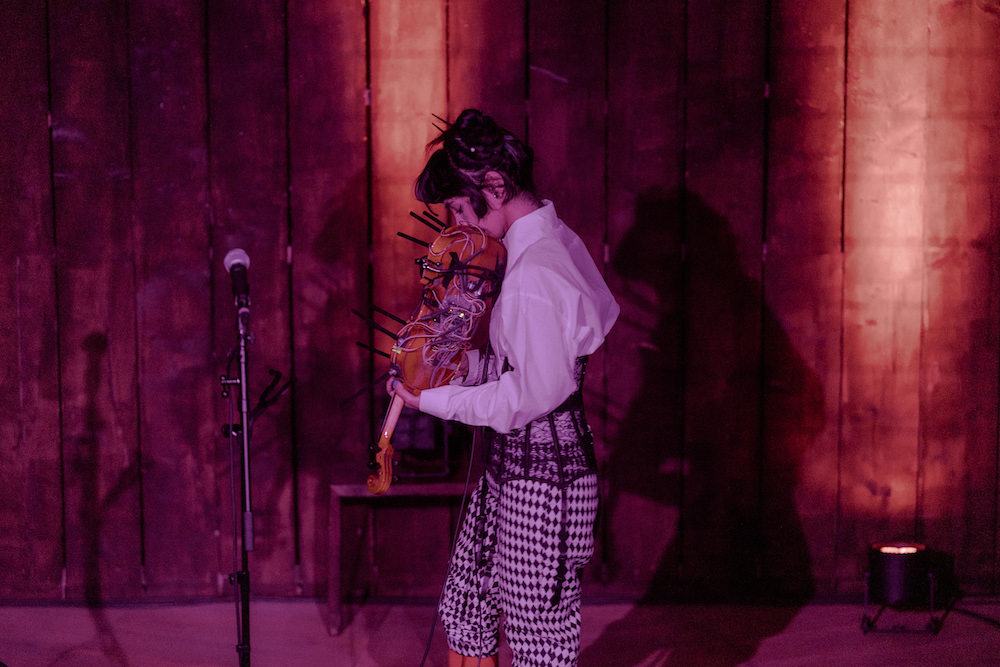
None such smoke and mirrors during the riveting Ex-Easter Island Head performance at Korzo. And amazingly so. None of the instrumentation is played by traditional means – and these studious experimentalists take an almost hunter-gatherer approach to extracting fresh sounds in all sorts of madcap ways. Guitars are used as percussive instruments, and their feedback manipulated in conjunction other objects – like, for instance, the tiny motors of mobile phones.
It’s more satisfying to eat a meal after witnessing its preparation step by step. But EEIH are not the slightest exhibitionist about it, instead embracing the inherent silliness of the method to their minimalist madness. Incidentally, they sound like the kind of nimble electronic dance music (even though the source of each sound is always tangible) someone like Caribou or Four Tet would be smitten with.
Alternately, EEIH conjure a segment that accidentally sounds like a lost interlude to Pink Floyd’s Dark Side Of The Moon. The most incredible moment of this set was when all the band members break into full vocal harmonisation, which they record on their phones. Said recordings are then replayed: watching all the band members experiment by pointing their phones at mics and modified guitars is a charmingly gauche sight in and of itself.
Miraculously, it turns into a squawking, maudlin arpeggiated sequence that forms the basis of another assiduous motorik exercise. And once those drums rush back in, you can’t help but pump your fist in the air in pure satisfaction. Aesthetically it strikes like some sequence in a Disney movie, where forest creatures work together to create some sort of optical illusion. What a heroic performance by a band that’s truly peerless in what they do.
On Sunday at Wendy Eisenberg played one of the most moving and life-affirming sets of the weekend at PAARD, forming a potent trio with Ryan Sawyer (drums) and Mari Maurice (pedal steel & violin). Eisenberg’s latest album Viewfinder copes with them dealing with the aftermath of seeing the world in full detail after getting eye-laser surgery. The beginning of the set offers audience a blissed out space/jazz rock odyssey – a riches of nimble grooves and layered atmospherics.
Eisenberg themself however, seems acutely aware of both time and place. Their set gradually simmers down into more rootsy, country-informed material from their repertoire, recognisant that some of the Rewire audience might step off the train. I for one, love the audacity of hearing some twang at a festival for experimental/extreme music: it feels like breaking a hardened shell, and appealing a softness hidden within. It was honestly beyond moving to see Eisenberg and their bandmates holding the audience’s hand from the set’s spaced-out beginnings to the open-hearted stillness of “In The Pines”. It helps that Eisenberg possesses the irreverent charisma to pull stuff like this off. Nothing like a little home cooking, right?
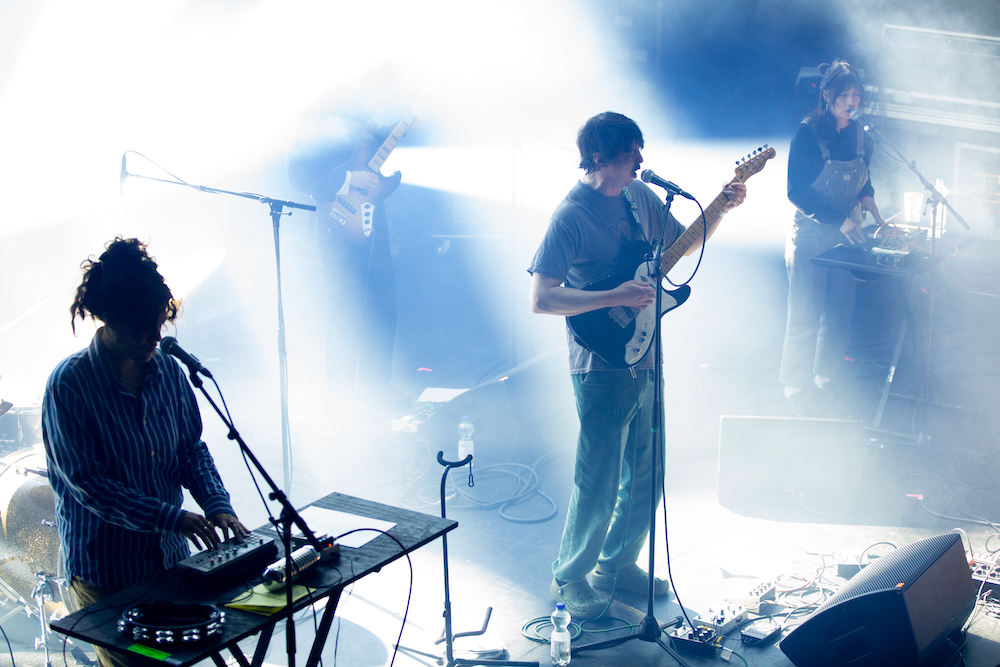
Wendy Eisenberg’s set represents the perfect fork road for the performances that follow right after: one can either check out the experimental folk of caroline or zone the fuck out at Panda Bear‘s set at PAARD. Some souls seem torn between them: once the vivacious psych pop sounds echo from above, they are drawn to them like moths to flame. We too opted for the latter option, and we were quick to find out this wasn’t the more electronic driven Panda Bear witnessed in this same venue back in 2018. This time Noah Lennox brought a full band lineup and a screen displaying dazzling, outlandish visuals. And good lord, do they sound amazing or what?
What the fuck is it about this year’s Rewire festival anyway, that makes damn near every act become the ‘LeBron James in Game 7 of the 2016 NBA Finals’ version of themselves!? This is simply the best Panda Bear has ever been. And the most unintentionally hilarious part of it is that Lennox and company actually walked off stage 10 minutes before they were meant to, completely ignorant of the crowd’s pleas for an encore.
They were probably just content that its 6pm and they finally have a whole night for themselves, to chill at the hotel, FaceTime with wives and kids, or just catching up on some sleep. All while leaving us trapped in the extramundane technicolor dream they conjured for us. And to think Panda Bear will do same damn thing tomorrow to another crowd, and the day after that, time and time again. Seriously, bands are crazy, man. Fuck you, Panda Bear. Fuck you.
Where Panda Bear provided some blissful escapism, Moin brought us right back to a more earthbound state. Tonight the post-hardcore band will present their latest LP You Never End with all the guest vocalists featured on the record: Olan Monk (who played a spirited set at Korzo on Saturday), Coby Sey and Sophia Al Maria will all front the band at various points during this set. Moin sound much bigger on stage than on record, thanks in large part to Valentina Magaletti‘s dynamic talents behind the drum kit.
The music is loud and combustible, but Magaletti’s playing adds a fluid and sensual tangent that’s undeniably magnetic. Particularly moving was Al Maria’s turn at the mic, preceding “Lift You” with an extended spoken word monologue – especially considering that her first calling is filmmaking and writing. Addressing the genocide in Palestine, she and Moin together instill us onlookers with the notion that sometimes there’s no choice but to confront the noise head-on.
After flanking Wendy Eisenberg, Mari Maurice – aka more eaze – joins claire rousay at the Lutherse Kerk to perform their collaborative record no floor. Soothing vestiges of cosmic Americana break down into messy, glitchy noise segments – as if large part of their long-distance correspondence is being blotted out. With the risk of sounding entirely pretentious, this made me think about what I said earlier in the review: how hard it is to find reprieve from all this ugliness the algorithms feed us every day.
This performance seems to express that inner strain almost in realtime. At sporadic intervals, more eaze and rousay do manage to find each other through all the strife, and those moments happen to be extremely moving. This intimacy manifests in the shape of a gorgeous auto-tuned pop song by the former. Near the end of the piece, they break out a violin melody that initially sounds frantic and anguished, but gradually solidifies into a resplendent, affectionate interlude – as if the music is literally being consoled into contentment.
Where more eaze and claire rousay express both our alienation and reconciliation, such a schism does not exists in Eiko Ishibashi‘s closing performance at the Lutherse Kerk. Almost out of thin air, Ishibashi summons chimera-like sonic tapestries with piano, flute, synths and voice, and – once these meditations are relayed to her looping station – they somehow don’t sound any less human within this majestic space. Where some artists have arduously explored and interrogated, Ishibashi’s set makes physicality, and its reflected figments, simpatico. Finally, we’re seeing them as they are: as the exact same picture.
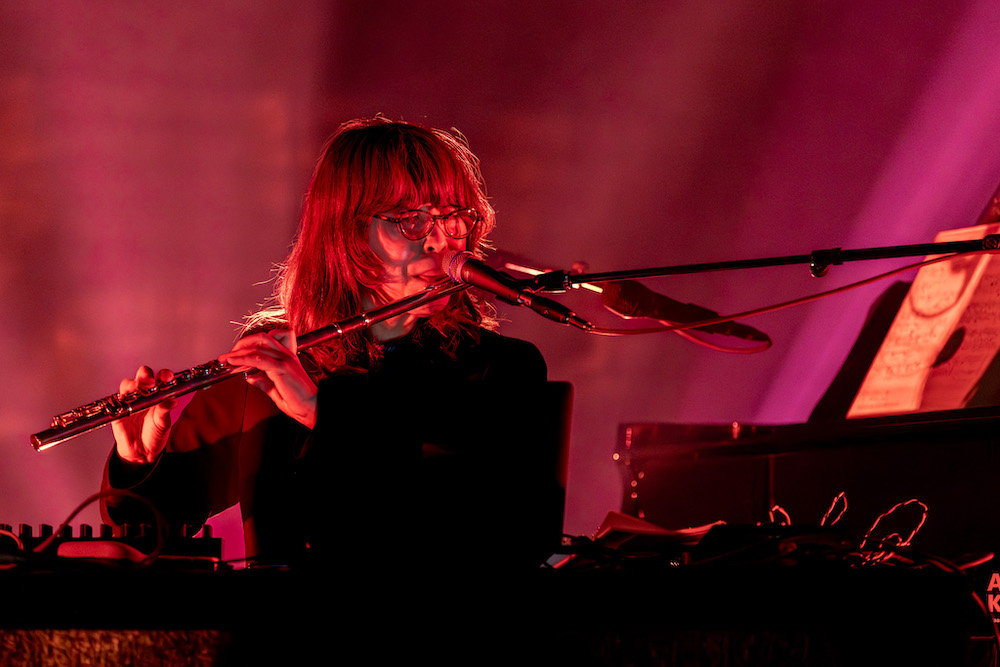
Photos: Moin (header) by Parcifal Werkman, Nala Sinephro by Maurice Haak, Red Brut & Maggie Khorrami by Joris van der Einden, Panda Bear by Kamiel Scholten, Eiko Ishibashi by Sabine van Nistelrooij

